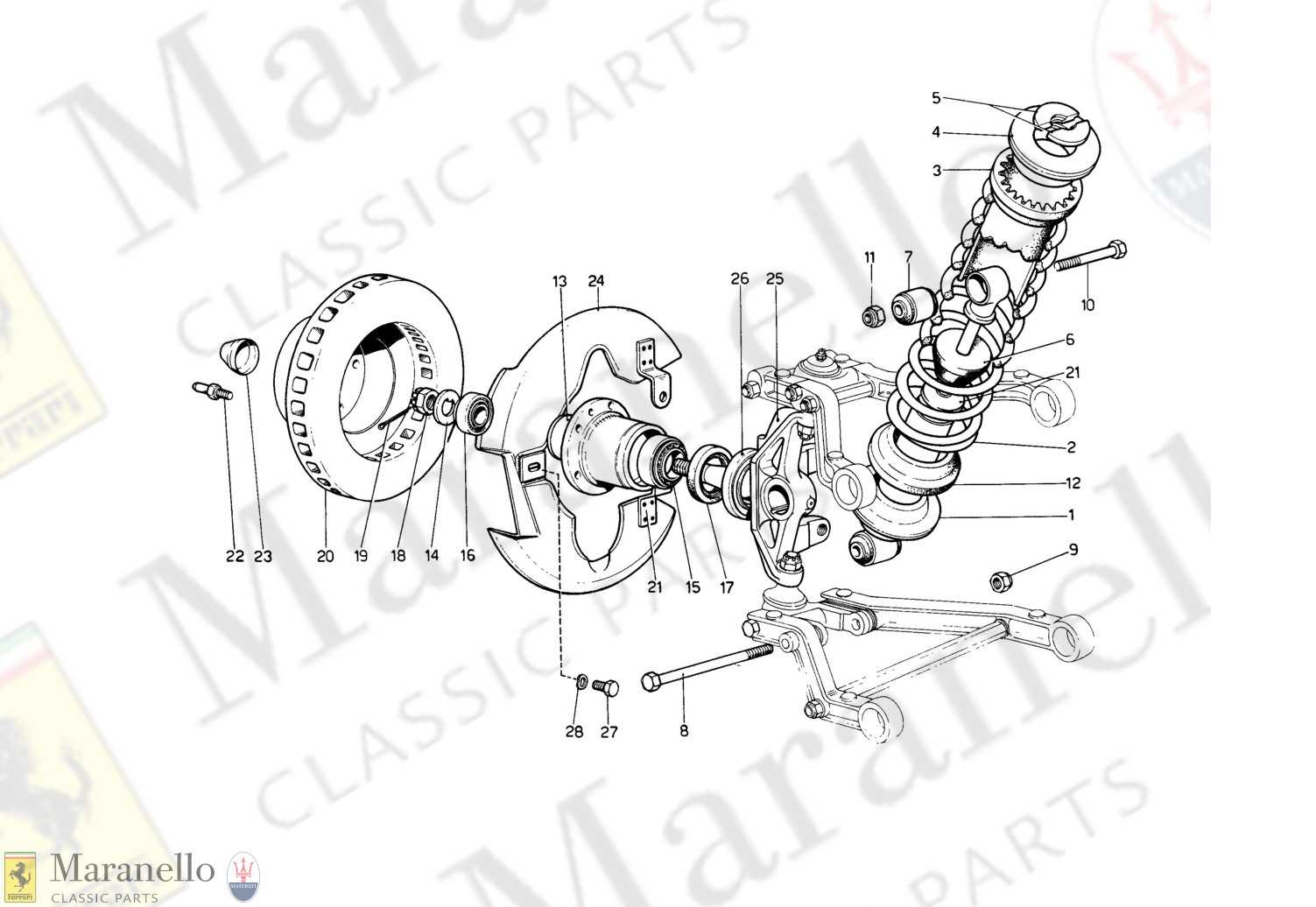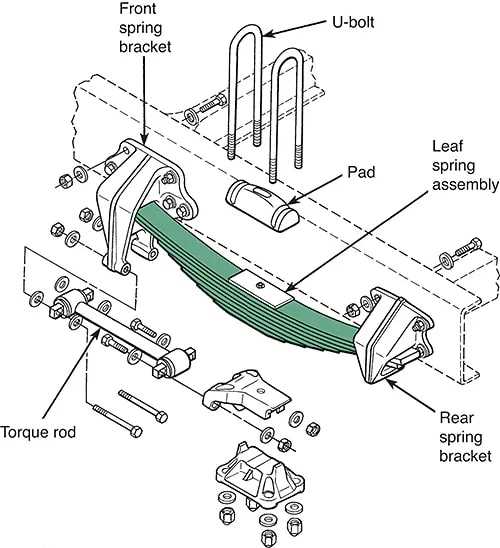
Every vehicle relies on a complex network of mechanisms designed to ensure a smooth ride and optimal control. These components work in harmony to absorb shocks and maintain stability, enhancing both safety and comfort during travel. A clear understanding of these systems is essential for anyone looking to improve their knowledge of automotive engineering.
To grasp how these systems function, one must explore the intricate layout of various elements that contribute to the overall performance of a vehicle. Each component plays a critical role in managing the interactions between the wheels and the road, helping to mitigate the effects of uneven surfaces and obstacles.
By examining the arrangement and relationships between these components, we can gain insights into their operation and importance. This knowledge not only aids in maintenance and repair but also fosters a deeper appreciation for the engineering marvels that make modern transportation possible.
Understanding Auto Suspension Systems
Effective vehicle dynamics rely on a complex system designed to absorb shocks and maintain stability. This framework plays a critical role in enhancing ride comfort and ensuring safe handling under various conditions.
Key Components

- Shocks and Struts
- Springs
- Control Arms
- Ball Joints
- Sway Bars
Functions and Benefits
- Improved ride quality through shock absorption
- Enhanced traction and grip during maneuvers
- Increased stability on uneven surfaces
- Optimal weight distribution for better handling
Components of Vehicle Suspension Explained
The intricate system that connects a vehicle to its wheels plays a crucial role in ensuring a smooth and controlled ride. This assembly not only affects handling but also enhances comfort by absorbing shocks from uneven surfaces. Understanding the elements involved provides insight into how vehicles maintain stability and safety on the road.
Key Elements of the System
At the core of this assembly are several essential components that work harmoniously. Shock absorbers serve to dampen vibrations, ensuring that the vehicle remains steady during various driving conditions. Springs, another vital component, bear the weight of the vehicle and allow for vertical movement, enabling it to adapt to bumps and dips.
Supporting Structures

In addition to the primary components, supporting structures like control arms and stabilizer bars contribute to overall performance. Control arms facilitate the connection between the frame and wheels, allowing for controlled motion. Stabilizer bars, on the other hand, reduce body roll during turns, promoting better handling. Together, these elements create a cohesive system that ensures both comfort and safety while driving.
Types of Suspension Systems Available
In the realm of vehicle dynamics, various frameworks are employed to enhance ride comfort and handling performance. Understanding these frameworks is essential for optimizing driving experiences and ensuring vehicle stability.
- Dependent System: This design connects the wheels, allowing them to react together to road conditions.
- Independent System: Each wheel moves independently, providing better handling and comfort on uneven surfaces.
- Air Suspension: Utilizes air-filled bags, offering adjustable ride height and improved comfort.
- Coil Spring System: Employs coil springs for support, known for simplicity and durability.
- Leaf Spring System: Consists of several layers of metal, commonly used in heavy-duty vehicles for strength.
Each of these frameworks serves distinct purposes, tailored to different driving needs and vehicle types.
Functionality of Suspension Parts
The intricate system responsible for providing stability and comfort during travel plays a crucial role in vehicle performance. Each component within this assembly is designed to interact seamlessly, ensuring a smooth ride and enhanced handling. Understanding the roles of these elements is essential for appreciating how they contribute to overall vehicle dynamics.
Key Functions
- Support Weight: These components bear the vehicle’s weight, distributing it evenly across the wheels to maintain balance.
- Absorb Shocks: They mitigate the impact of bumps and irregularities in the road, preventing excessive vibration from affecting the chassis.
- Enhance Control: A well-functioning assembly improves steering response, allowing for precise maneuverability.
- Maintain Tire Contact: Ensuring that tires remain in constant contact with the road surface maximizes traction and stability.
Importance of Quality Components
Utilizing high-quality materials in the construction of these elements is vital for durability and performance. Poorly made components can lead to:
- Increased wear and tear on tires.
- Compromised handling, resulting in unsafe driving conditions.
- Higher maintenance costs due to frequent replacements.
Overall, the effective operation of this critical assembly significantly enhances safety and comfort during travel.
Common Suspension Issues and Solutions
Understanding the frequent challenges faced by vehicle support systems is essential for maintaining a smooth driving experience. Various factors can contribute to these problems, but recognizing the symptoms and knowing how to address them can prevent further complications.
Here are some of the most common issues:
- Uneven Tire Wear: This can indicate alignment problems or worn components.
- Noise Over Bumps: Clunks or rattles when driving over irregularities often signal failing shock absorbers or struts.
- Excessive Leaning: A vehicle that leans during turns may have weakened springs or sway bars.
- Vibration While Driving: This could result from imbalanced wheels or worn out bushings.
Here are potential solutions for these issues:
- Regular Inspections: Routine checks can help identify problems early before they escalate.
- Alignment Adjustments: Proper alignment can resolve uneven tire wear and enhance handling.
- Component Replacement: Worn shocks or struts should be replaced to restore comfort and stability.
- Wheel Balancing: Ensuring wheels are balanced can eliminate unwanted vibrations.
By addressing these concerns promptly, vehicle owners can ensure better performance and safety on the road.
Importance of Regular Suspension Maintenance
Maintaining the system responsible for supporting a vehicle’s weight and ensuring a smooth ride is crucial for overall performance and safety. Regular upkeep of this system not only enhances driving comfort but also contributes to the longevity of various components, ultimately leading to a more reliable driving experience.
Ignoring maintenance can lead to a host of issues, including poor handling, uneven tire wear, and compromised safety. It is essential to monitor and service these systems routinely to prevent costly repairs and ensure optimal functionality.
| Benefit | Description |
|---|---|
| Improved Handling | Regular checks ensure the vehicle responds better to steering inputs and road conditions. |
| Enhanced Safety | A well-maintained system reduces the risk of accidents caused by poor stability and control. |
| Cost Efficiency | Preventive maintenance can save money in the long run by avoiding expensive repairs. |
| Increased Comfort | Regular upkeep provides a smoother ride by effectively absorbing shocks from the road. |
In conclusion, prioritizing the maintenance of this vital system is essential for any vehicle owner. By being proactive, one can enjoy a safer, more comfortable, and economically sensible driving experience.
How to Read Suspension Diagrams
Understanding technical illustrations related to vehicle dynamics is crucial for both enthusiasts and professionals. These visuals provide a wealth of information about the components and their relationships within the system. By grasping the symbols and notations used, one can effectively analyze the functionality and performance characteristics of the assembly.
To begin, familiarize yourself with the common symbols and color codes. Each element typically has a specific representation that conveys its role and function. For instance, lines may indicate different types of connections, while various shapes represent distinct components. Learning these representations is essential for accurate interpretation.
Next, pay attention to the layout of the illustration. The arrangement of elements can indicate how forces are transmitted throughout the system. Understanding the flow of energy and motion between components will enhance your comprehension of how the entire mechanism operates.
Additionally, refer to any accompanying notes or legends that provide further context. These annotations often clarify the relationships and specifications of the elements involved. They can also highlight important details that may not be immediately apparent from the visual alone.
Finally, practice is key. Regularly engaging with these technical representations will build your confidence and understanding over time. As you become more familiar with the structure and terminology, you will find it easier to assess and diagnose issues, ensuring a more comprehensive grasp of vehicle dynamics.
Upgrading Your Suspension: What to Know
Enhancing the components that support your vehicle’s weight can significantly improve handling, comfort, and overall performance. This upgrade process involves various considerations that every vehicle owner should keep in mind to achieve the desired results.
Before diving into modifications, it’s essential to understand the following key points:
- Goals: Define what you want to achieve. Are you looking for better ride quality, improved handling on curves, or increased load capacity?
- Types of Upgrades: Familiarize yourself with different options available. Common upgrades include shock absorbers, coil springs, and stabilizer bars.
- Compatibility: Ensure that new components are compatible with your vehicle’s make and model. Mismatched parts can lead to suboptimal performance.
- Installation: Decide whether to tackle the installation yourself or seek professional assistance. Proper installation is crucial for safety and functionality.
Additionally, consider the impact of modifications on other systems in your vehicle:
- Alignment: After upgrades, a proper wheel alignment is necessary to maintain handling and tire wear.
- Tires: Upgraded components might require different tire specifications for optimal performance.
- Braking: Enhanced handling may affect braking distances, so ensure your braking system is also up to par.
By understanding these elements, you can make informed decisions that align with your driving preferences and ensure a smoother, more responsive ride.
Impact of Suspension on Vehicle Performance
The system responsible for connecting a vehicle’s body to its wheels plays a crucial role in determining how well it handles various driving conditions. This component affects not only the ride quality but also the overall stability and control during maneuvers. A well-designed setup can enhance comfort while ensuring safety and responsiveness on the road.
Different types of configurations offer unique benefits, impacting traction, weight distribution, and cornering capabilities. Understanding these effects is essential for optimizing performance across diverse terrains and driving styles. Here, we examine key influences on vehicle dynamics:
| Aspect | Effect on Performance |
|---|---|
| Ride Comfort | Aids in absorbing road imperfections, reducing driver fatigue. |
| Handling | Enhances responsiveness and stability, particularly during turns. |
| Traction | Improves grip on surfaces, allowing for better acceleration and braking. |
| Weight Distribution | Balances load across wheels, influencing overall control and maneuverability. |
| Durability | High-quality materials contribute to longevity and consistent performance. |
Investing in the right setup not only enhances comfort and safety but also elevates the driving experience, making it a key consideration for vehicle enthusiasts and everyday drivers alike.